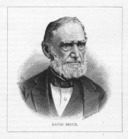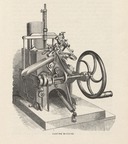In the halcyon days of ATF the largest, busiest, and most intriguing casting bays were those in the Hand and Steam Department. Here, side by side and row after row, were the hand-cranked pivotal casting machines and their powered "steamer" counterparts (driven from pulleys and flat belts) which could cast anything in a myriad of matrix-drives on 3- to 208-point bodies. (11)
- Theo Rehak. Practical Typecasting. (p. 11).[NOTE: This set of Notebooks is presently under rather heavy development, and there are great big holes in it. I've only put it online in this state because other pages link to items in it.]
The pivotal type caster (also called the Bruce type caster, after its inventor) was the most important type casting machine ever invented, and was one of the most important machines enabling the industrial revolution. Without it there simply would not have been enough type to print the information necessary for the great transformations in society and industry in the middle and later 19th century. It was also one of the primary enabling factors in the development of ornamented types in the 19th century. This allowed the printing industry to respond to the new pressures from lithography, and produced (as we can see now, having in part recovered from the aesthetic limitations of the generations from Morris to Morison) one of the finest periods of Artistic Printing and typography ever. The pivotal type caster remained in commercial use from the 1840s through the 1990s - and has been used for commercial typecasting in the 2010s - yet it remains very poorly understood.
Note: Certain variations of the pivotal typecaster became distinguished under their own names and are therefore covered in their own Notebooks. These include:

Introduction
A brief account of the pivotal type caster and its place in history.

Literature
A survey of the historical and technical literature on the pivotal or Bruce type casting machine (mostly references, with some reprints).

Clarifications
The "Discharging Pin" does not move (Bullen's description is entirely inaccurate).
"Choker" / "Joker" / "Jobber."

Issues
[NOT DONE] Controversies concerning the pivotal caster, both historical and technical.
[Lauritz Brandt] [Legros & Grant's claim against Bruce]

Evidence
Our knowledge of the history of the pivotal type caster is not as certain as we might believe it to be. This is a chronological list of what we think we know and why we think we know it.

Census
[NOT ONLINE (as not yet even remotely complete)] An informal international census of surviving pivotal type casting machines.

Principles of Operation
[NOT DONE] How a pivotal typecaster actually works, in detail.

Parts Lists
Every machine should have an illustrated Parts List. Here, I'll develop such a list for my own pivotal caster. It should serve as a more or less representative list for similar machines.
[INCOMPLETE] For the logic and sources involved in establishing names for each of the parts, see the Principles of Operation, above.
All portions of this document not noted otherwise are Copyright © 2008-2010, 2013-2014 by David M. MacMillan and Rollande Krandall.
Circuitous Root is a Registered Trademark of David M. MacMillan and Rollande Krandall.
This work is licensed under the Creative Commons "Attribution - ShareAlike" license. See http://creativecommons.org/licenses/by-sa/3.0/ for its terms.
Presented originally by Circuitous Root®
Select Resolution: 0 [other resolutions temporarily disabled due to lack of disk space]